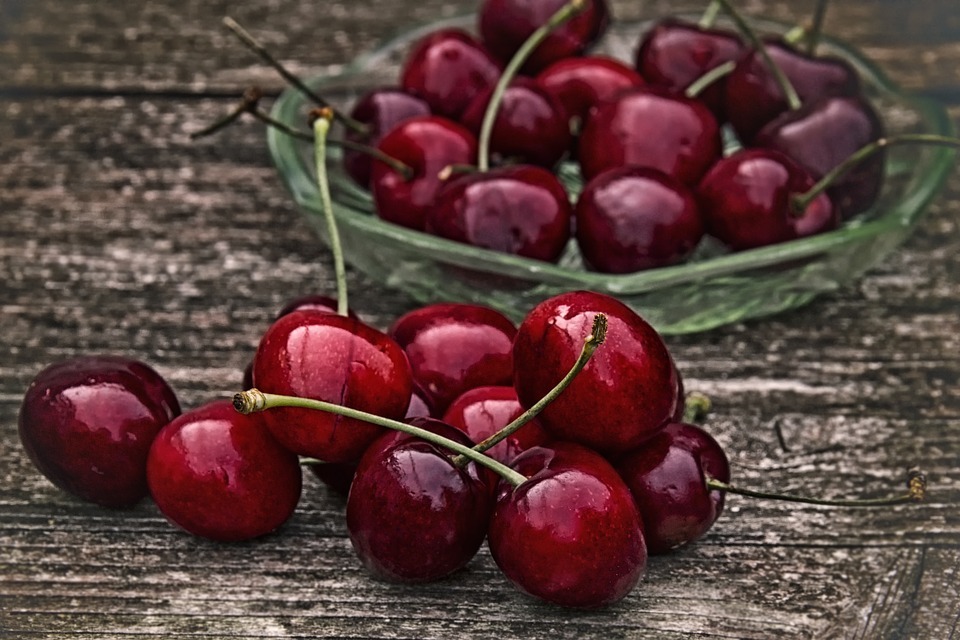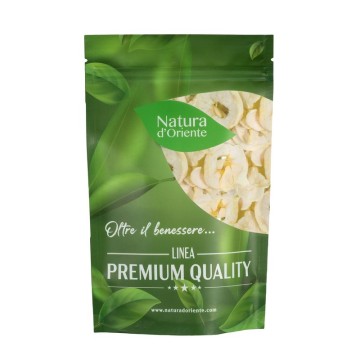Dehydrated cherries
Cherries have become increasingly popular as a snack among the many fruits available in a dried version. This, because they retain their greedy flavor (one cherry leads to another!) But also most of the vitamins and nutrients.
They provide sugars for energy, so cherries are an excellent nutritious snack, and are classified as one of the health protective foods. Let's see why.
Dehydrated cherries: properties and benefits.
Cherries are delicious but also rich in vitamins, like many fruits. In particular, the properties of vitamin C are available through dehydrated cherries, in a good daily dose.
Like copper, vitamin C helps the production of collagen, therefore a beneficial substance for the growth of new tissues, against skin aging, and with a role in wound healing .
Dehydrated cherries contain copper, moreover, which helps in the production of collagen. It keeps tissues strong and protects against free radicals that can contribute to their damage.
Vitamin A , also contained in cherries, supports the growth of new cells, nourishes the skin and helps to consolidate healthy vision.
Cherries are known for their good levels of pectin , a substance (polysaccharide sugar) capable of regulating the level of LDL or bad cholesterol in the blood, preventing its increase.
Being a soluble fiber, it is capable of forming jellies in contact with water, which can retain some molecules such as bile acids which are then eliminated from the body at the end of digestion. To create new bile acids, the body uses LDL cholesterol which is removed from the blood, and therefore is reduced in our body.
In addition, pectin promotes correct intestinal functions, with its emollient characteristics that can be valid both in anti-diarrhea and in case of constipation. In this regard, dried cherries have a mild laxative effect, if consumed regularly.
Cherries are fruits rich in antioxidants, even in the version of dehydrated cherries, in particular anthocyanins. These are versatile flavonoid pigments, which give the cherries their deep red color. Anthocyanins prevent the development of free radicals in the body, which are the atoms that damage our cells and promote aging.
On the contrary, antioxidants can maintain cellular well-being and defend our functions, both physical and cognitive.
The high level of these antioxidants contained in cherries helps the body reduce post-workout muscle discomfort, for faster recovery. Therefore, you can consume dehydrated cherries before and after exercise. The balanced content of minerals and vitamins helps to recharge the body with energy and beneficial nutrients.
A curiosity among the characteristics of cherries is that they are one of the few natural food sources of melatonin - a hormone that regulates sleep-wake cycles. They can therefore be useful for relaxing and promoting sleep - as well as being useful for "overcoming" jet lag.
Among the important trace elements contained in dehydrated cherries, there are also minerals such as zinc, iron, magnesium, potassium, sulfur, manganese and cobalt, and some B vitamins.
Origins and History of cultivation
Cherries today are a popular fruit all over the world but their origin is probably from a plant found in Asia Minor, according to some scholars. It was the birds that spread their seeds first in Egypt (around the 7th century BC) and then in Europe, via Greece.
In Roman times a legend speaks of Lucullus, who brought the best cherries from Cappadocia, and later Pliny the Elder described the variants of this plant, about ten, in his Naturalis Historia. Already in Roman times, cherries were dried, and in the laid tables of the Renaissance they came back into fashion, and the cultivation of their plants were described.
British colonists brought cherry trees to North America in the 17th century, and German traders brought them to Japan in the 1800s.
Everywhere, cherries became a hit due to the beauty of the plants, the flowers, and the taste of the fruit. Famous were those of Versailles, in the large greenhouses dedicated to their crops.
Nowadays, many countries produce their own localized varieties, among which the main species are sweet cherry and sour cherry (from which the sour cherry, morello cherry and sour cherry varieties are descended).
The Bing and Rain cherriesier come from North America, Kordia and Regina cherries from Europe and so on for other variations. Italy, at a European level, is one of the main producers of cherries with over 150 varieties derived from sweet cherry, divided into the categories of tenerine and duracine.
With such high popularity, it's no surprise that cherries are popular both fresh and dried - people crave their benefits and taste, even when they're not in season. Obviously, once dried, cherries are stronger and more durable, which makes them perfect for storage.
Plant and Fruit
 The Cherry is one of several trees belonging to the genus Prunus. Commercial cultivation includes sour cherries (Prunus cerasus) and sweet cherries (Prunus avium).
The Cherry is one of several trees belonging to the genus Prunus. Commercial cultivation includes sour cherries (Prunus cerasus) and sweet cherries (Prunus avium).
A number of species are also grown only as ornamental plants for their beautiful flowers, while the dark red wood of some cherry species is used for the production of fine furniture.
Most cherry species are native to the Northern Hemisphere, where they are widely cultivated, while the greatest concentration of species appears to be in East Asia.
For their fruits, sweet cherries, black cherries and duca are mainly cultivated, which are crosses of sweet and sour cherries.
Sweet cherries are large, up to 11 meters high and produce a fleshy drupe generally heart-shaped, about 2 cm in diameter. The color of the cherry varies from yellow to red to almost black.
The acidity content of the cherry is very low, higher in the sour cherry to which it gives the characteristic sour taste. Sour cherry trees are smaller, rarely exceed 5 meters in height and have a fruit with a rounded shape, dark red and very acidic. Duke cherries are intermediate both in the characteristics of the tree and in those of the fruit.
Cherry trees are grown in all areas of the world where the soil is not too dry, temperatures are moderate: winters that are not too harsh and summer temperatures moderate.
They require winter cold to bloom early enough in the spring. In Asia, especially Japan, cherry tree varieties have been selected for the beauty of their flowers and most of them do not bear fruit.
Nutritional values of dehydrated cherries
Like most fruits, dried cherries are useful for adding vitamins and minerals to the diet. They are a particularly abundant source of vitamin A, especially pro-vitamin A (beta-carotene), as well as B vitamins, vitamin C and several other micronutrients.
This version of dried dehydrated cherries does not contain excessive calories (about 350 per 100 grams), as well as a fair fiber content (about 2.5 g / 100 g) but little protein (about 1 g / 100 g) .
The fruit contains vitamin C (about 19 mg / 100 g) and Vitamin A (about 140 µg / 100 g), and vitamin B6 (about 0.1 mg / 100 g).
Among the various minerals present there are good levels of phosphorus (about 120 mg / 100 g), zinc (0.6 mg / 100 g), calcium (about 38 µg / 100 g), iron (about 0.68 / 100 g), potassium (about 376 mg / 100 g), magnesium (about 22 mg / 100 g), and copper.
How to consume or use dehydrated cherries in the kitchen
Dried cherries add a touch of flavor to smoothies and yogurts, and can also be the best antioxidant-rich energy snack.
Among dried fruit, cherries are suitable for a low-calorie diet as hunger-breaking snacks, which satiate thanks to the fiber and sweet taste.
Dehydrated cherries can easily be added to dried fruit mixes, fruit salads, and as decorations on ice cream, muffins, cupcakes and cakes.
They can also be used as ingredients for desserts and energy bars. Whole dehydrated cherries can also be useful for decorations for aperitifs and cocktails, or to flavor some dishes with their sweetish flavor.
Dehydrated cherries: side effects and contraindications
Ultimately, there are few risks associated with dried cherries, unless there is an intolerance or allergy to the fruit. However, remember to enjoy them in moderation and in the correct quantities, because they can provide high concentrations of sugars, carbohydrates and calories.
People with diabetes, in particular, should avoid excessive use of dried cherries, as they do not promote the increase in blood sugar.













 No reward points for this product.
No reward points for this product.
 The Cherry is one of several trees belonging to the genus Prunus. Commercial cultivation includes sour cherries (Prunus cerasus) and sweet cherries (Prunus avium).
The Cherry is one of several trees belonging to the genus Prunus. Commercial cultivation includes sour cherries (Prunus cerasus) and sweet cherries (Prunus avium).

![Natural dehydrated grapefruit without added sugar [NATURADORIENTE]](https://www.naturadoriente.com/10190-home_default/pompelmo-naturale-disidratato-senza-aggiunta-di-zucchero.jpg)












